Userpilot vs Usetiful: Which is Better for User Analysis?
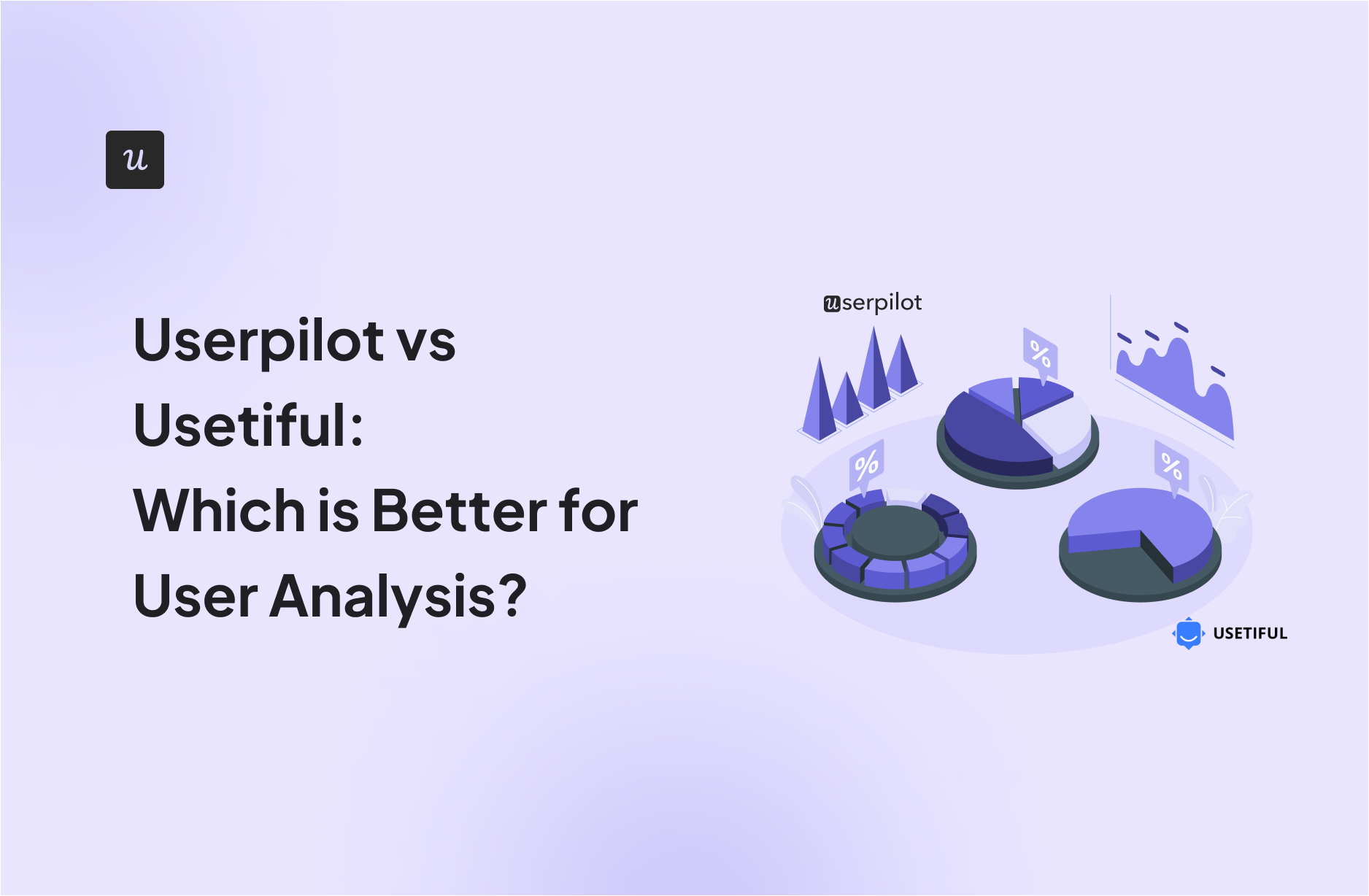
Is Userpilot or Usetiful the best tool for user analytics? And is there a better software that would better fit your needs?
With so many alternatives on review sites, it’s a bit tricky to really choose one.
You need to consider your priorities and what functionality you’ll need from the tool to get the job done. Then there’s also the price that needs to match your budget. Right?
In this post, we’ll discuss exactly that – what the perfect tool for performing user analysis should deliver and which will be the best choice for your company’s needs.
Let’s dive in!
TL;DR
- Let’s explore how Userpilot and Usetiful compare when it comes to performing user analysis.
- Userpilot is a product growth platform that drives user activation, feature adoption, and expansion revenue. It also helps product teams collect user feedback, streamline onboarding, and gather actionable insights from analytics.
- Usetiful offers analytics on most of its content, like product tours, smart tips, and checklists. You can see how many people clicked on them, completed the journeys, and viewed each of the steps, among other things.
- Usetiful offers several helpful features, such as product tours, tooltips, onboarding checklists, and banners. However, there are a few areas where Userpilot stands out. These include:
- Advanced user segmentation: Userpilot lets you segment users based on a wide array of attributes, behavior patterns, demographics, and custom events. You can even group users based on their responses to in-app surveys. Usetiful’s user segmentation parameters pale in comparison.
- In-depth user analytics: With Userpilot, you get a detailed glimpse into how users move through your app, interact with on-page elements, and use different features. These insights play a crucial role in improving product adoption and user retention. On the other hand, Usetiful only offers basic analytics, such as how many users started and completed an in-app experience.
- More survey options: Userpilot lets you choose from a broad spectrum of built-in survey templates, including NPS, CSAT, CES, and microsurveys. You can even build surveys from scratch and use advanced branching logic to tailor the flow of questions according to a user’s response. Usetiful lacks such variety in survey options.
- Robust integrations: Unlike Usetiful, Userpilot is compatible with a wide range of commonly used tools, such as Google Analytics, HubSpot, Amplitude, Heap, and Segment.
- Excellent customization: Userpilot’s built-in customization options are more extensive than Usetiful’s. You can modify the visual appearance, position, and other aspects of various UI patterns without getting caught up in the complexities of CSS.
- Get a Userpilot demo and drive your product growth code-free.
What is user analysis?
User analytics is the process of capturing and analyzing user behavior within your product. This helps to understand how different segments act in-app, identify friction and drop-off points, and make data-driven decisions.
Must have features for user analytics tools
Choosing the right user analytics tool is important for understanding your customers’ behavior and optimizing their journey. Here’s what you should look for:
- Event tracking: The chosen tool should come with the ability to set up events for monitoring in-app behavior. It should be capable of tracking both client and server-side events so you can have a better understanding of how users interact with your product.
- Analytics dashboards: These include no-code reports and dashboards that you can easily build to draw meaningful insights from collected data. It’s also highly recommended that these dashboards have advanced segmentation filters so you can filter data for a better understanding of specific user groups.
- Surveys: In addition to behavioral data, it’s also necessary that the chosen tool is capable of collecting and analyzing feedback. Such direct data from customers can help you understand customer expectations and work on improving your product.
Userpilot for user analytics
User analytics lets you track and analyze the behavior of users within your product. Userpilot lets you filter through customers from a unified dashboard, extract insights from specific segments or time periods, and create custom segments for all users who meet certain conditions. Here’s an overview of Userpilot’s analytics features:
- Users dashboard: Userpilot’s users dashboard gives you an overview of all user data in one place. You’ll be able to filter by segments, which companies users are from, or when they were last seen active. You can also export data in bulk as a CSV or perform actions on individual users.
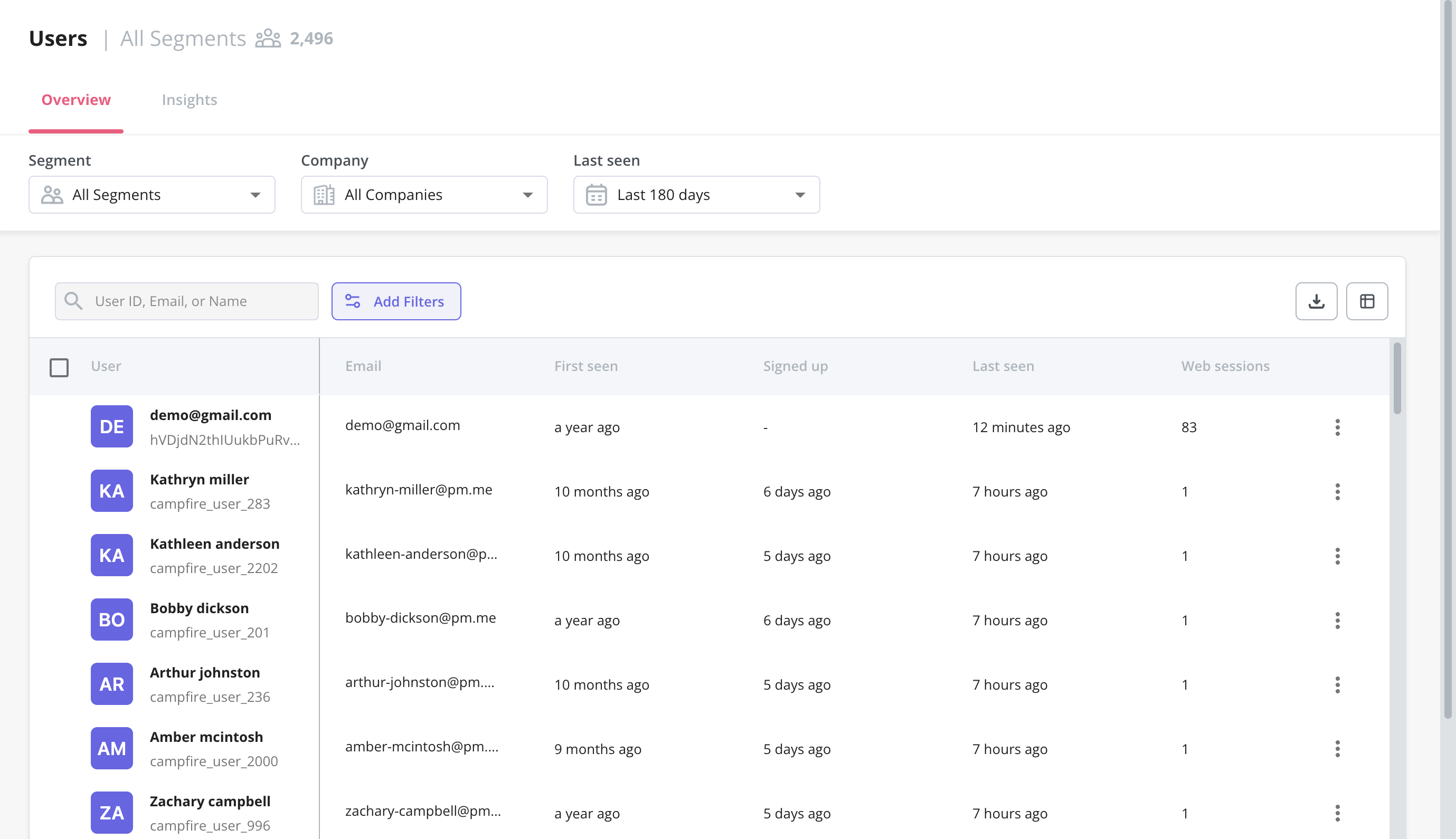
- User and company profiles: Here you can view data related to a certain user/company to gain insights into their behavior i.e. Top events, Top pages, Sessions, Sentiment – user’s feedback (NPS & Survey), etc. With such granular insights, you can go one step further with your personalization efforts.

User profile with top event data.
- Audience insights: Much like the overview dashboard, the Insights section lets you filter metrics by segment, company, and time period. You’ll be able to choose between a daily, weekly, or monthly view and then compare data between the current and previous time periods.
- Conditional segmentation: Practical use cases for user analytics include creating segments for all users that meet certain conditions. For instance, you could reach out to companies in a certain country when creating a new flow or target customers who have tried certain features.

- Saved reports: With Userpilot, you can create funnels, trends, retention tables, and path reports. The saved reports dashboard lets you view, edit, duplicate, or delete any trend and funnel reports you’ve created. You’ll also be able to sort by report type, filter by the teammate who created the report, or export in bulk if you need a CSV of your user analytics.
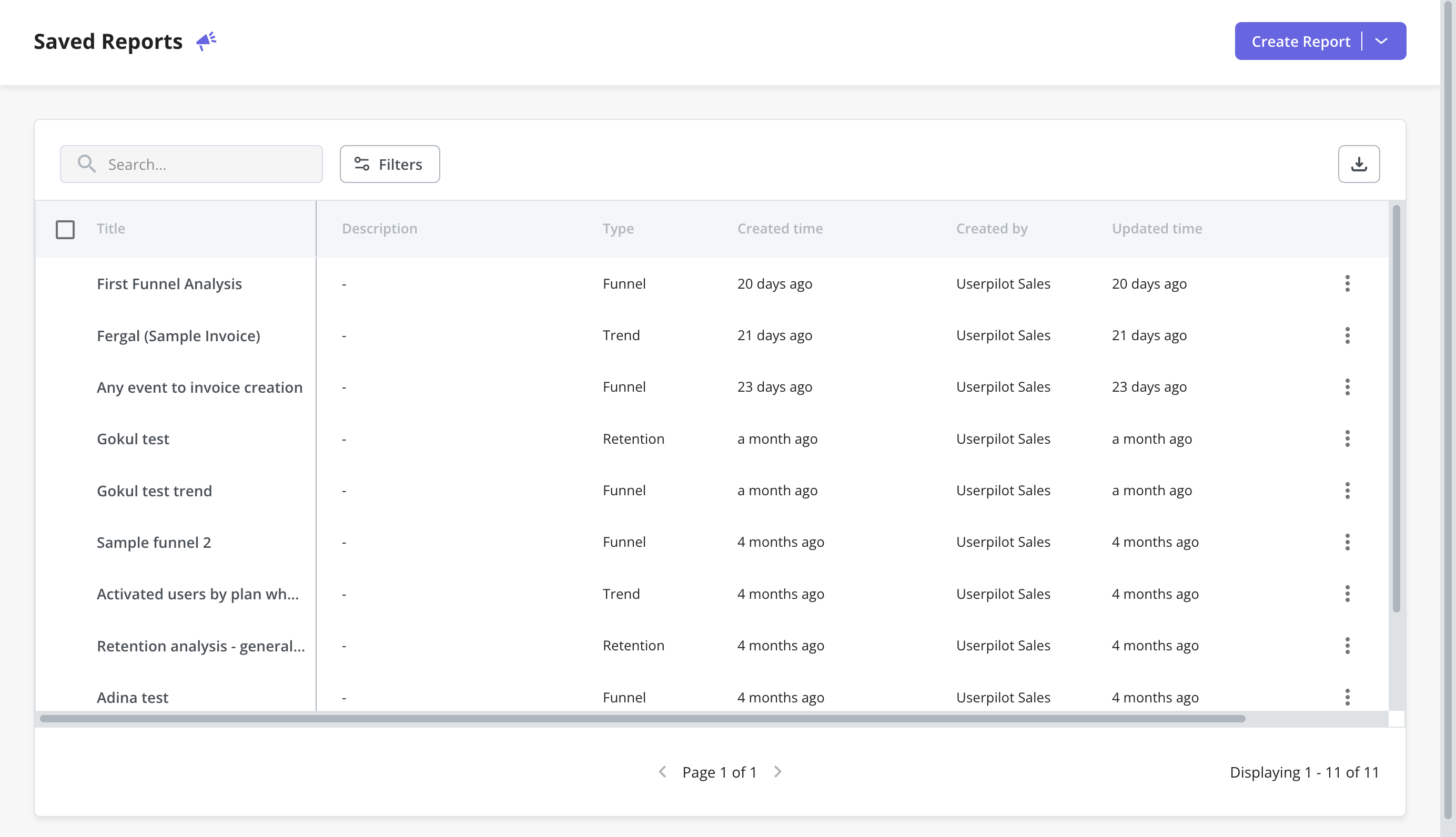
- Dashboards: Once you log in to Userpilot, you will see a collection of dashboards that collects all your key product metrics like product usage, user activation, feature engagement, etc. These dashboards are automatically available without you having to set anything up.
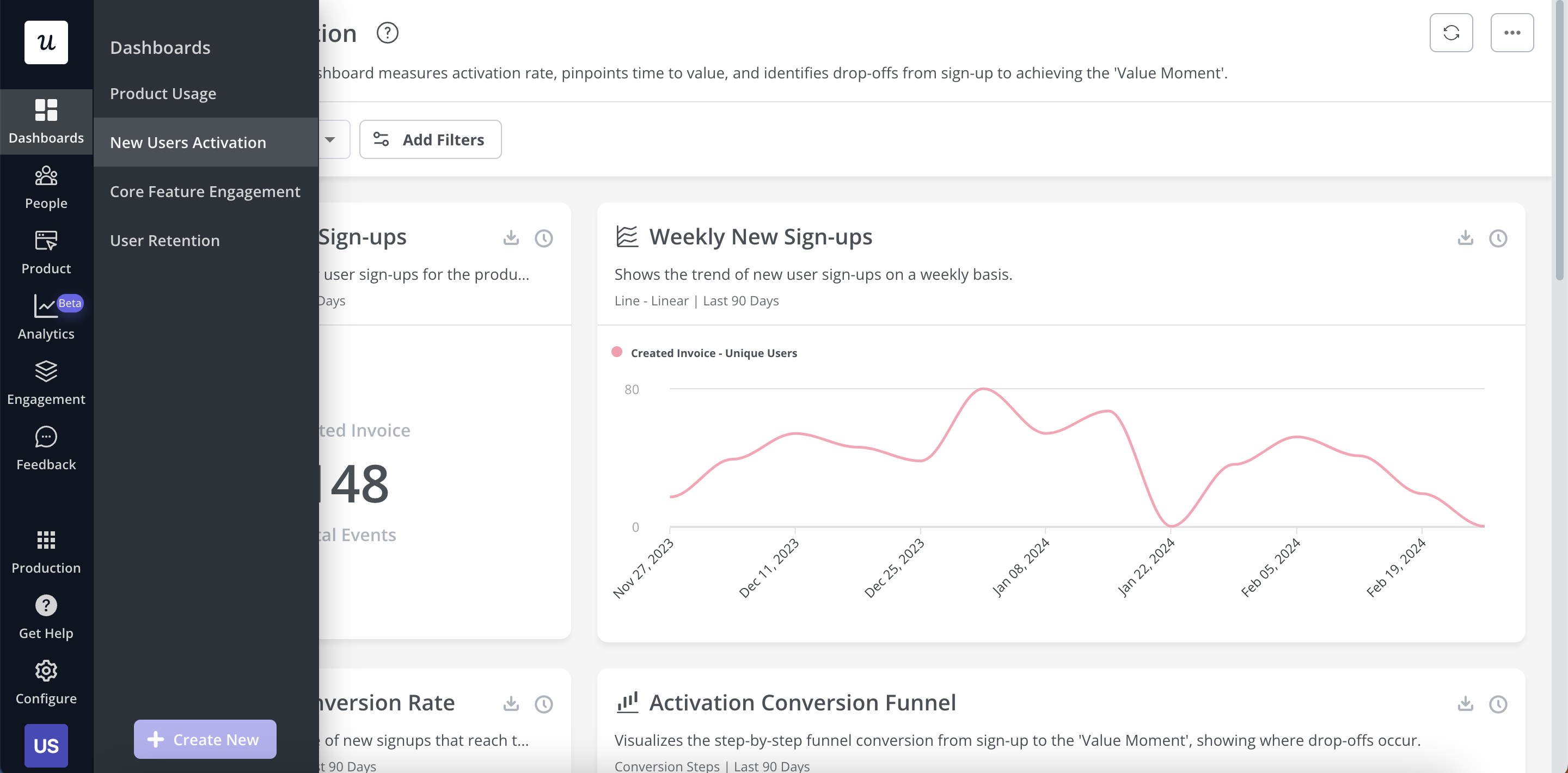
Types of analytics dashboards available in Userpilot currently.
In-app events in Userpilot
Tracking and analyzing event data gives you a better understanding of user behavior so you can capitalize on opportunities to improve the in-app experience.
Here are the ways you can use Userpilot as an event-tracking tool:
- Event tracking: The Userpilot flow builder lets you track custom events by tagging individual features (Feature Tag), by API (called Tracked Events) or by setting them up using a combination of feature tags and tracked events (Custom Events).

- Feature tags: Userpilot’s no-code feature tagger lets you track important features/elements based on different interaction types (clicks, hovers, and text inputs). You can then display the engagement and performance of different features through heatmaps.
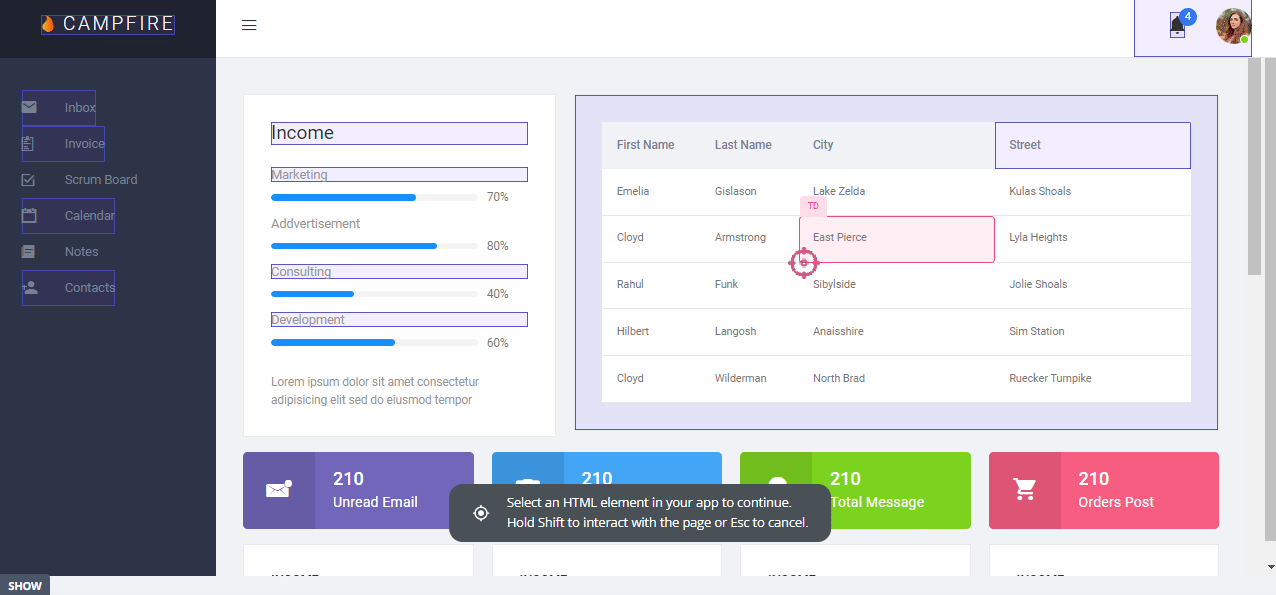
- Data integrations: Userpilot has native integrations with popular analytics tools like Amplitude, Mixpanel, Google Analytics, and more. This makes it possible to sync your event data across multiple tools within your tech stack.

In-app surveys in Userpilot
In-app surveys are an effective way to collect direct feedback from users without being at the whim of their email inboxes. Userpilot’s built-in functionality lets you create surveys, translate them, and track granular survey analytics that offer additional user insights.
Here are the Userpilot features you can use when building in-app surveys:
- Survey templates: Userpilot’s no-code survey builder has 14 templates to choose from. These include NPS, CSAT, and CES surveys among others for collecting quantitative and qualitative feedback from users. You can add a series of questions to gather valuable insights.

- Survey translation: Userpilot’s AI localization feature lets you translate surveys in a matter of minutes. All you need to do is add the desired locale and leave the rest to Userpilot. You can also make manual tweaks to translations if needed.
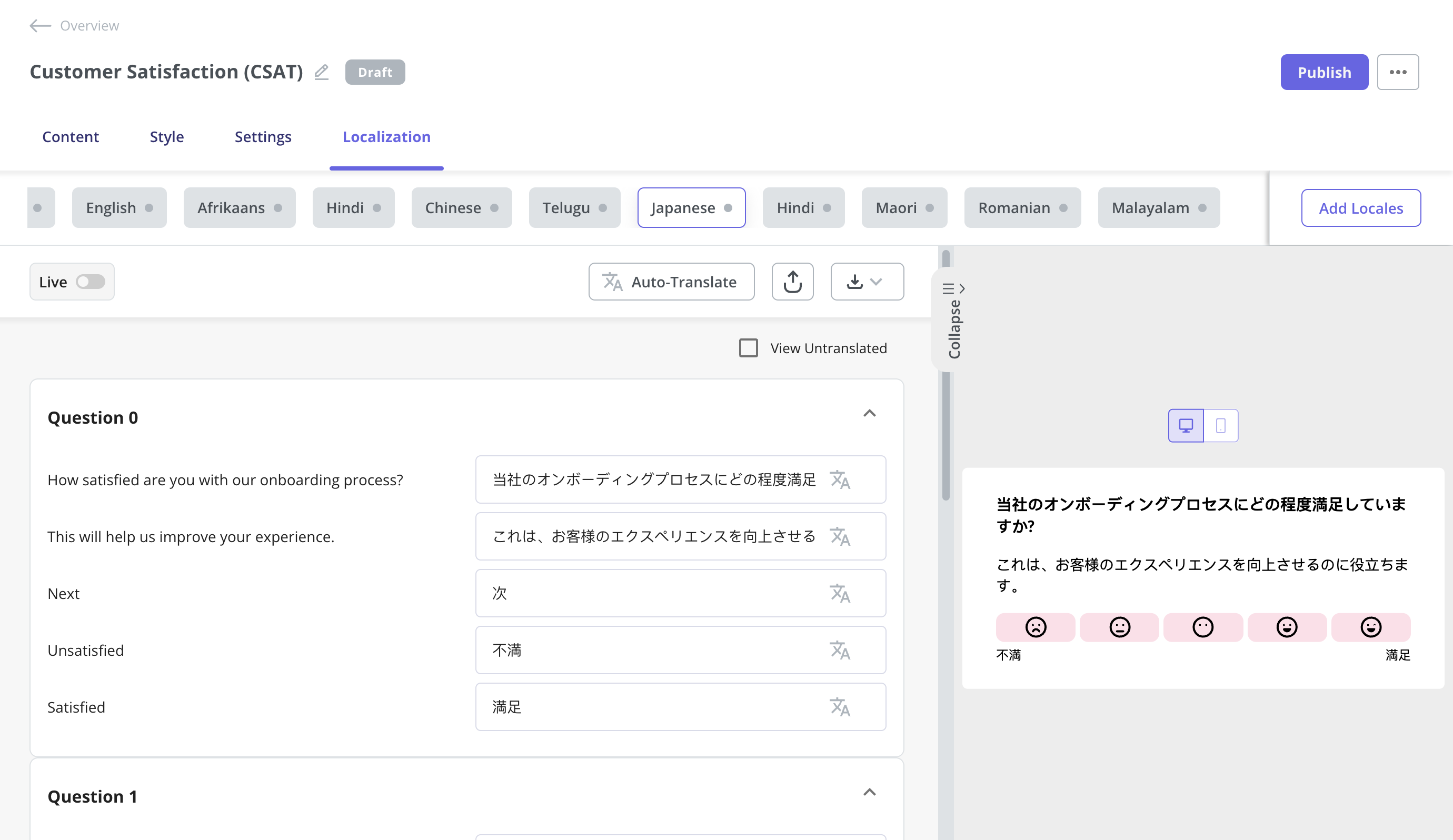
- Advanced analytics: Userpilot has detailed analytics that shows what percentage of users chose a specific option, summarizes the most popular choices, and lets you browse through open-ended responses to extract insights from qualitative feedback.

Usetiful for user analytics
Collecting and analyzing user behavior data is an integral part of product development. It can help you improve product activation, user retention, and feature adoption.
Here’s how you can track user analytics with Usetiful:
- You get access to basic user analytics, such as how many users started and completed an in-app experience. Also, you can find out how many product tours, tooltips, banners, and other UI patterns were activated in a month.
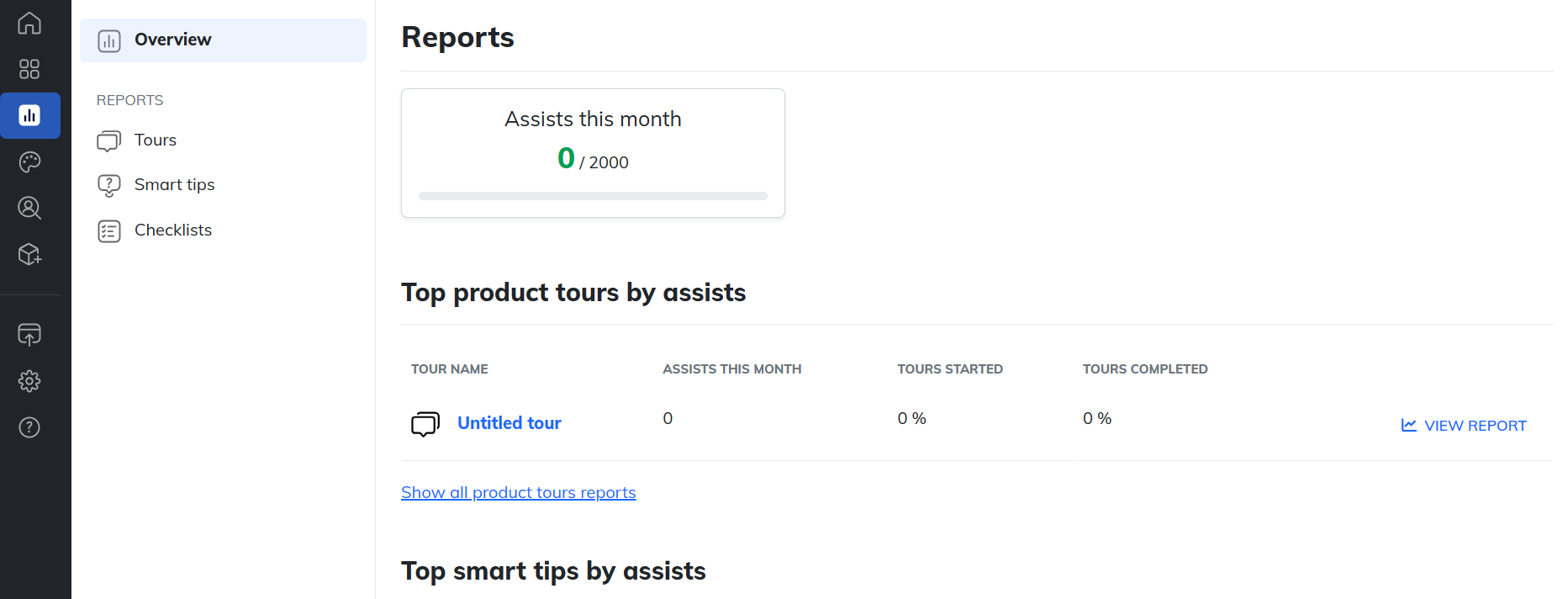
- You can also leverage the Users feature for a closer look at individual users. It provides an overview of how each user interacts with various Usetiful experiences. However, this feature is only available in the paid plans.
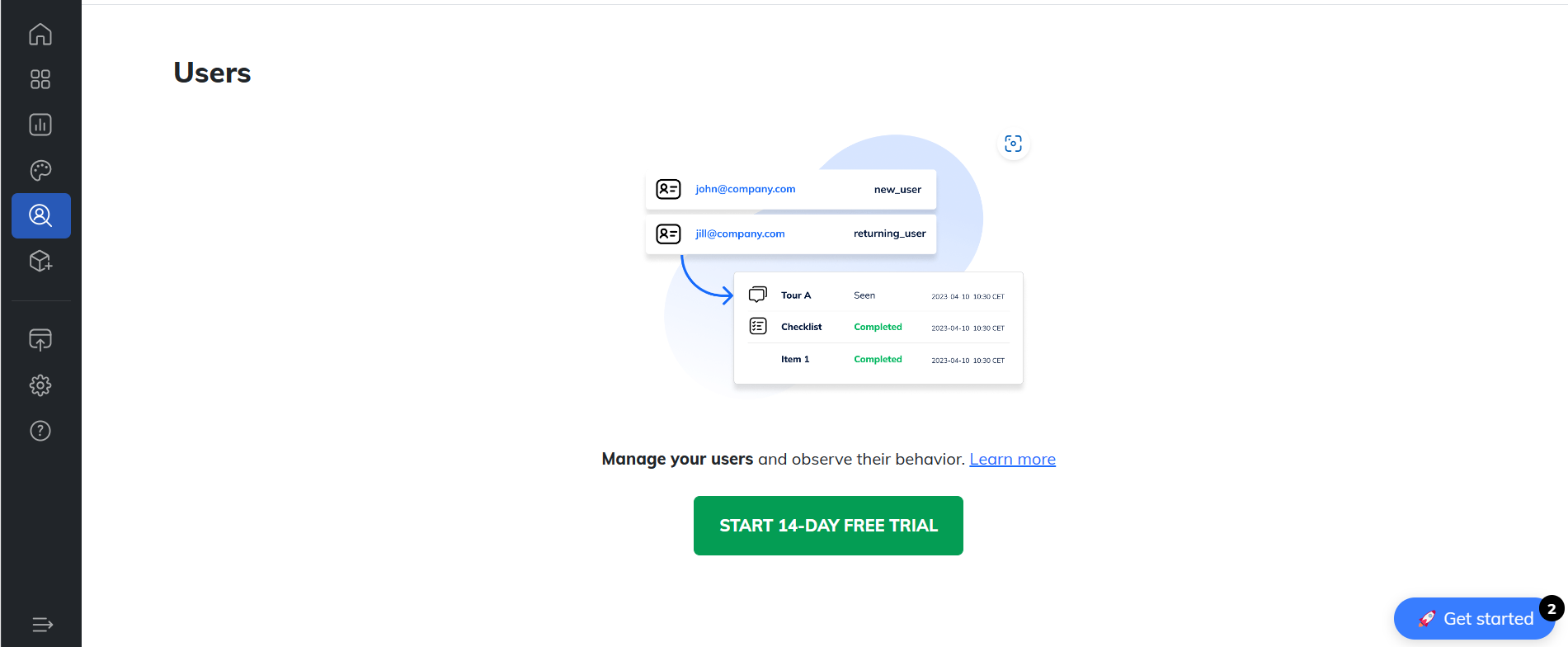
It’s worth keeping in mind that Usetiful doesn’t offer a detailed glimpse into user engagement and in-app behavior. If you’re looking for more in-depth user analytics and insights, a platform like Userpilot might be a better fit.
In-app events in Usetiful
Tracking in-app events can help you understand how users interact with your app. This can help inform product development and redesign to improve the overall user experience.
Usetiful offers analytics on most of its content, like product tours, smart tips, and checklists. You can see how many people clicked on them, completed the journeys, and viewed each of the steps, among other things.
However, there’s little it does when it comes to in-app events tracking. Instead, you have to add trigger events to your product tours. Then, you have to connect your app to Google Analytics and install it on that particular page. You’d then have to add custom definitions within Google Analytics to track your events. In a nutshell, you have to rely on a third-party platform for in-app event tracking.
![]()
A platform like Userpilot, on the other hand, comes with built-in events tracking features to help you understand your users better.
In-app surveys in Usetiful
Whether you want to improve product adoption, user retention, or conversion rates, in-app surveys are a must. They enable you to collect feedback from users and gain insight into their sentiments. This helps you make calculated and well-informed decisions regarding product development, marketing, and pricing.
When it comes to implementing in-app surveys, Usetiful offers limited functionalities. You can add reaction-based or NPS surveys to different steps of a product tour. However, you don’t get the option to create independent multi-step surveys with branching logic. Nor can you access advanced survey analytics and trigger personalized in-app experiences based on qualitative feedback.
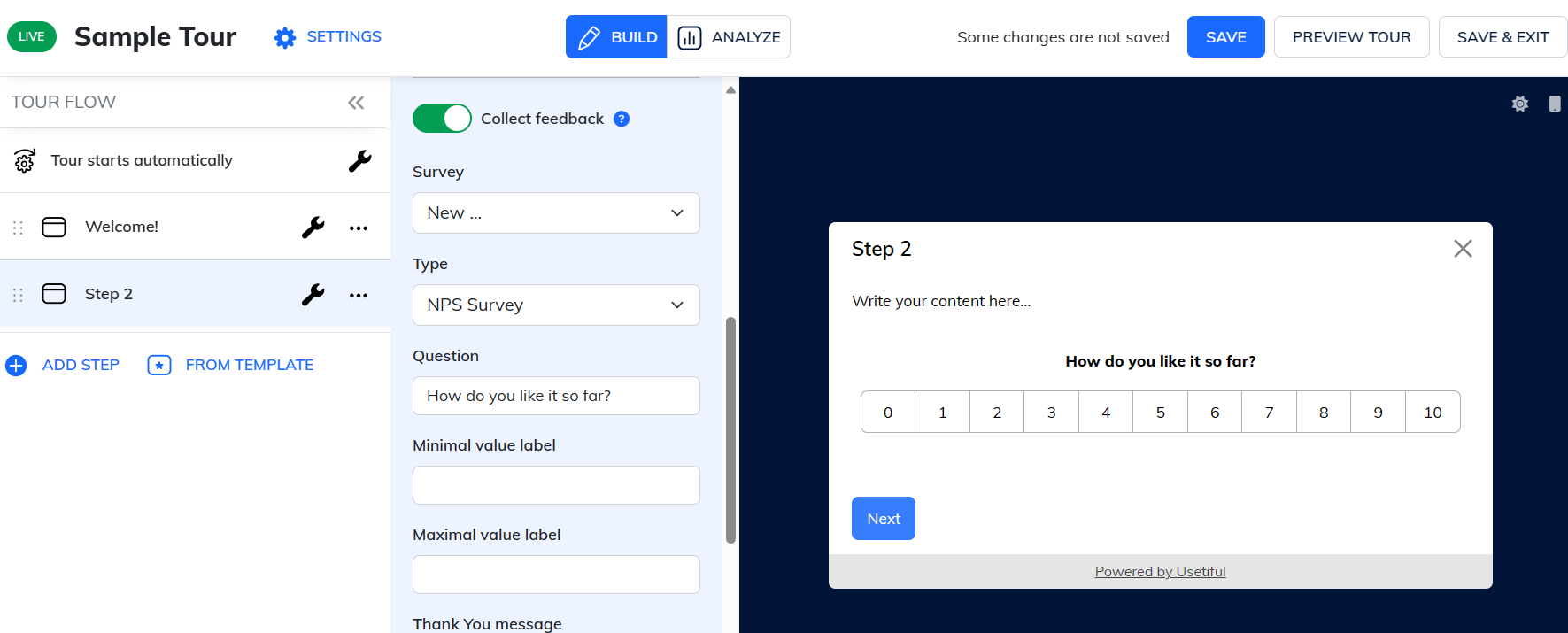
If you’re looking for a product adoption platform that offers a wide array of survey templates and in-depth survey analytics, Userpilot would be a better fit.
Pros and cons of Userpilot
While Userpilot’s versatile feature set and relatively affordable entry-level plan make it an attractive option for most SaaS companies, there are bound to be certain scenarios where it simply isn’t the right tool for the job.
Here are a few scenarios where you should look for a different tool other than Userpilot:
- Tight budgets: Userpilot is the best option for mid-market SaaS companies who want to get the most bang for their buck with plans including unlimited feature usage, fully interactive walkthroughs, advanced analytics, integrations, and a wide array of feedback collection mechanisms — all starting at $249/month. However, early-stage startups with sub-$100 budgets may want to look into options like Intercom, UserGuiding, and Product Fruits.
- Employee onboarding: Userpilot’s Chrome extension and no-code flow builder only works with your product, meaning it can’t be used to onboard employees to third-party apps. For onboarding internal teams, WalkMe is a viable solution that you should consider.
- Mobile apps: Userpilot is only compatible with responsive web apps as a narrow focus is essential to providing the best functionality needed to onboard users. As such, those looking to onboard users to mobile apps should check out platforms like Appcues and Pendo.
Pros of Userpilot
As a full-suite digital adoption platform, Userpilot has all the features you need to onboard users, track analytics, and gather feedback from customers without writing a single line of code. Here are a few pros of using Userpilot as your product growth solution:
- No-code builder: Userpilot’s Chrome extension lets you build flows, add UI elements, and tag features without writing a single line of code.
- UI patterns: There are plenty of UI patterns to choose from when using Userpilot, such as hotspots, tooltips, banners, slideouts, modals, and more!
- Startup-friendly: Userpilot’s entry-level plan gives you access to all available UI patterns so you can hit the ground running.
- Walkthroughs and flows: Build engaging interactive walkthroughs and personalized onboarding flows that target specific segments of your user base.
- Self-service support: Build an in-app resource center to help users solve problems, customize its appearance to align it with your brand, and insert various types of content (videos, flows, or chatbots) to keep your customers satisfied.
- A/B testing: Userpilot’s built-in A/B testing capabilities will help you split-test flows, iterate on the best-performing variants, and continually optimize based on user behavior.
- Feedback collection: Userpilot has built-in NPS surveys with its own unified analytics dashboard and response tagging to help you retarget users. There are other survey types to choose from and you can even create your own custom survey.
- Survey templates: There are 14 survey templates to choose from so you can gather feedback on specific features or run customer satisfaction benchmarking surveys like CSAT and CES.
- Advanced analytics: Userpilot lets you analyze product usage data, monitor engagement on all in-app flows, and use the data to create user segments that are based on behaviors instead of demographics.
- Event tracking: Userpilot’s no-code event tracking lets you tag UI interactions (hovers, clicks, or form fills) and group them into a custom event that reflects feature usage.
- Third-party integrations: Userpilot has built-in integrations with tools like Amplitude, Mixpanel, Kissmetrics, Segment, Heap, HubSpot, Intercom, Google Analytics, and Google Tag Manager so you can share data between all the solutions in your tech stack.
Cons of Userpilot
Of course, no tool is perfect and there are a few cons to consider before choosing Userpilot as your user onboarding or product growth solution:
- Employee onboarding: Currently, Userpilot only supports in-app customer onboarding.
- Mobile apps: Userpilot doesn’t have any mobile compatibility which could make it difficult for developers with cross-platform applications to create a consistent user experience for both versions of their product.
- Freemium plan: There’s no freemium Userpilot plan so those bootstrapping their startup and need sub-$100 solutions should consider more affordable onboarding platforms like UserGuiding or Product Fruits.
Pros and cons of Usetiful
If you’re looking for a user-friendly tool to improve user onboarding and product adoption, Usetiful ticks all the boxes. But it may not be the right fit for everyone. You’ll likely need to look for a Usetiful alternative in the following scenarios:
- You want complete control over the look and feel of in-app experiences: Usetiful’s default customization options are limited to font and color. If you want modals, in-app notifications, tooltips, and other elements to seamlessly blend with your product’s branding, Usetiful may not fit the bill.
- You want to collect detailed user feedback: Usetiful offers a small selection of survey templates, such as NPS surveys and reactions. If you’re looking to gain insight into customer satisfaction and user sentiment, it’s wiser to consider an alternative.
- You want to track user behavior and engagement: Usetiful’s basic analytics capabilities make it unsuitable for teams that want to dig deeper into user behavior data. You can’t use it to make strategic decisions regarding product development and marketing.
Pros of Usetiful
As with any digital adoption platform, Usetiful offers a wide array of features to simplify user onboarding and boost product adoption. Its benefits include the following:
- Ease of use: Usetiful offers an intuitive and user-friendly interface that’s easy to navigate, even for users from non-technical backgrounds. Most features are accompanied by contextual tooltips, making it easy to get the hang of the platform. The no-code WYSIWYG builder simplifies things further for non-technical teams.
- Hassle-free implementation: Setting up Usetiful for your product is equally straightforward. All you have to do is add a Javascript code to your app. It requires minimal developer support.
- Works on third-party apps: Usetiful doesn’t just work on products you’ve built. You can also use it to create in-app experiences in third-party tools. In other words, it’s suitable for onboarding new users and employees alike.
- Chrome extension: Usetiful comes with a Chrome extension that sits on top of your product. It comes in handy for non-technical users who want to build flawless in-app experiences in a few clicks.
- Affordable pricing: With paid plans starting at €29 per month, Usetiful offers excellent value for money. It’s also one of the few digital adoption platforms with a forever-free plan. That makes it suitable for small teams with a limited budget. Plus, you have ample freedom to take it for a spin before investing in a paid plan.
Cons of Usetiful
Despite its simplicity and affordability, Usetiful isn’t without flaws. As one of the newer digital adoption platforms in the market, it’s prone to performance issues. Other drawbacks include:
- Limited customizability: Customization options on Usetiful are limited to fonts and colors. Advanced customization is only available through CSS classes, which isn’t always feasible for non-technical users. If your product already has an established brand identity, the lack of customization capabilities might leave you disappointed.
- Lack of built-in integrations: Usetiful supports integration with a handful of third-party tools, such as Survio and Tradly, and HubSpot integration is currently in the works. The lack of third-party integrations restricts the platform’s utility for advanced user analytics and segmentation. You can use webhooks to connect to other apps, but it can be cumbersome when you already have an extensive tech stack.
- Doesn’t work for mobile apps: While Usetiful works for your own and third-party tools, you can only use it on web-based apps. The software doesn’t work on mobile devices (or apps).
- Basic analytics: When it comes to user behavior and product analytics, Usetiful leaves a lot to be desired. The analytics feature provides an overview of the number of users who start and complete an in-app experience. But beyond that, you don’t get in-depth insights into how users navigate your product and interact with different on-screen elements (like Userpilot does).
- Limited in-built survey templates: While Usetiful lets you create in-app surveys, your options are restricted to a small selection of survey templates. Also, you can’t analyze survey responses in detail or trigger in-app experiences based on them.
Userpilot vs Usetiful: Which one fits your budget?
Understanding the cost implications is paramount when selecting the right solution for user analysis, so here’s a detailed pricing comparison of Userpilot and Usetiful.
Pricing of Userpilot
Userpilot’s transparent pricing ranges from $249/month on the entry-level end to an Enterprise tier for larger companies.
Furthermore, Userpilot’s entry-level plan includes access to all UI patterns and should include everything that most mid-market SaaS businesses need to get started.

Userpilot has three paid plans to choose from:
- Starter: The entry-level Starter plan starts at $249/month and includes features like segmentation, product analytics, reporting, user engagement, NPS feedback, and customization.
- Growth: The Growth plan starts at $749/month and includes features like resource centers, advanced event-based triggers, unlimited feature tagging, AI-powered content localization, EU hosting options, and a dedicated customer success manager.
- Enterprise: The Enterprise plan uses custom pricing and includes all the features from Starter + Growth plus custom roles/permissions, access to premium integrations, priority support, custom contract, SLA, SAML SSO, activity logs, security audit, and compliance (SOC 2/GDPR).
Pricing of Usetiful
Usetiful’s pricing is transparent and easy to understand, with four different plans. These include:
- Free: You can create one product tour, one checklist, and multiple smart tips across one page.
- Plus: You can build unlimited product tours, checklists, and smart tips and customize their look and feel. You also get access to basic segmentation features and user analytics. Pricing starts at €29 per month and allows up to 2 team members.
- Premium: You can create in-app experiences without the Usetiful watermark and use the Assistants widget for self-service support. You also get access to advanced segmentation features and employee onboarding tools. Pricing starts at €69 per month and allows up to 7 team members.
- Enterprise: You can use Usetiful on multiple products and environments and get access to more extensive integrations. Pricing is available on request and depends on your specific requirements.

All paid plans come with a 14-day free trial and a 30-day money-back guarantee. But you’ll need to enter your credit card details to start the free trial. Additionally, all plans support as many websites or apps as you want.
With plans starting at €29 per month, Usetiful is among the most affordable digital adoption platforms. That makes it a good fit for startups and small businesses with limited budgets.
Userpilot vs Usetiful – Why Userpilot might be a better choice?
Usetiful offers several helpful features, such as product tours, tooltips, onboarding checklists, and banners. However, there are a few areas where Userpilot stands out. These include:
- Advanced user segmentation: Userpilot lets you segment users based on a wide array of attributes, behavior patterns, demographics, and custom events. You can even group users based on their responses to in-app surveys. Usetiful’s user segmentation parameters pale in comparison.
- In-depth user analytics: With Userpilot, you get a detailed glimpse into how users move through your app, interact with on-page elements, and use different features. These insights play a crucial role in improving product adoption and user retention. On the other hand, Usetiful only offers basic analytics, such as how many users started and completed an in-app experience.
- More survey options: Userpilot lets you choose from a broad spectrum of built-in survey templates, including NPS, CSAT, CES, and microsurveys. You can even build surveys from scratch and use advanced branching logic to tailor the flow of questions according to a user’s response. Usetiful lacks such variety in survey options.
- Robust integrations: Unlike Usetiful, Userpilot is compatible with a wide range of commonly used tools, such as Google Analytics, HubSpot, Amplitude, Heap, and Segment.
- Excellent customization: Userpilot’s built-in customization options are more extensive than Usetiful’s. You can modify the visual appearance, position, and other aspects of various UI patterns without getting caught up in the complexities of CSS.
What do users say about Userpilot?
Most users laud Userpilot for its versatile feature set, ease of use, and responsive support team:
I recently had the pleasure of using Userpilot, and I must say it exceeded all my expectations. As a product manager, I’m always on the lookout for tools that can enhance user onboarding and improve overall user experience. Userpilot not only delivered on these fronts but also went above and beyond with its impressive new features, unparalleled ease of use, and truly exceptional customer support.
What truly sets Userpilot apart is its outstanding customer support. Throughout my journey with Userpilot, the support team has been responsive, knowledgeable, and genuinely dedicated to helping me succeed. Whenever I had a question or encountered an issue, their support team was always there to assist promptly, going above and beyond to ensure my concerns were addressed effectively.

Source: G2.
Of course, other users are also kind enough to share constructive criticism regarding specific features like event tracking filters:
“The filtration while analyzing specific events is a little confusing. Understanding of custom properties and data management configuration could have been more organised.”

Source: G2.
Conclusion
This is the end of our thorough comparison between Userpilot and Usetiful. You should be able to make a confident decision by now. If you’re looking for a solid tool for user analytics that promises great value for money, give Userpilot a go. Book a demo today.



